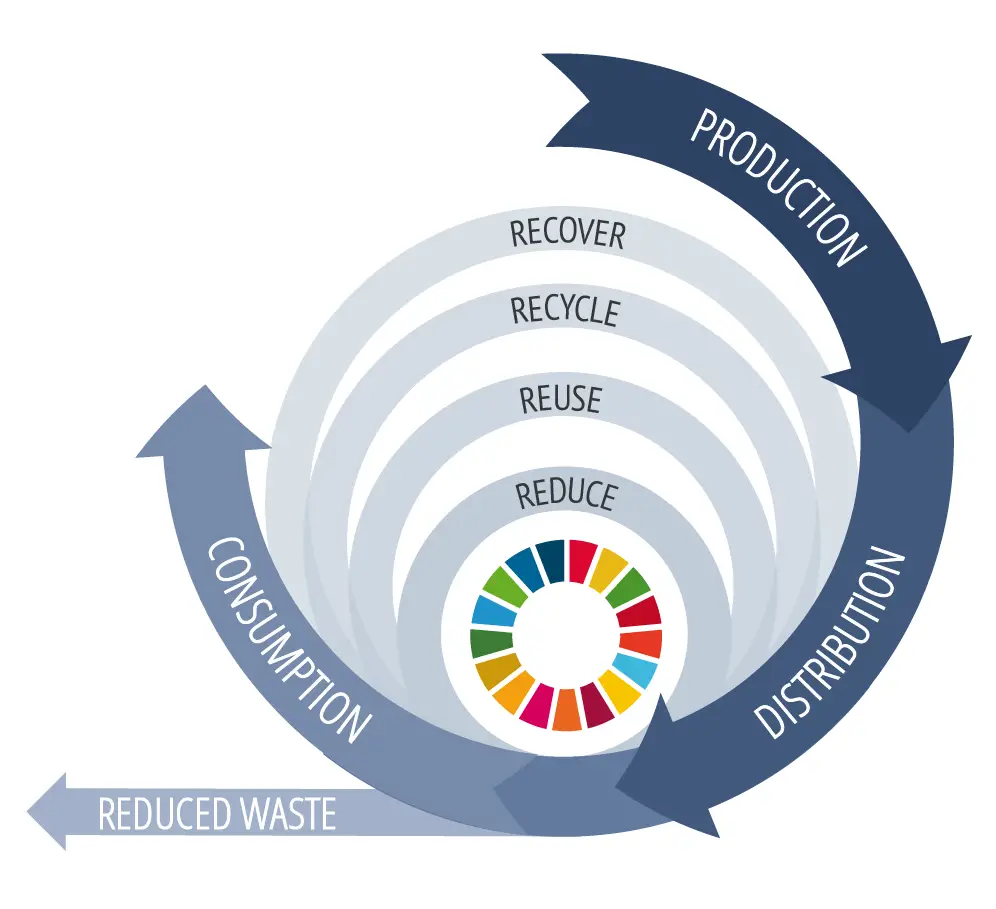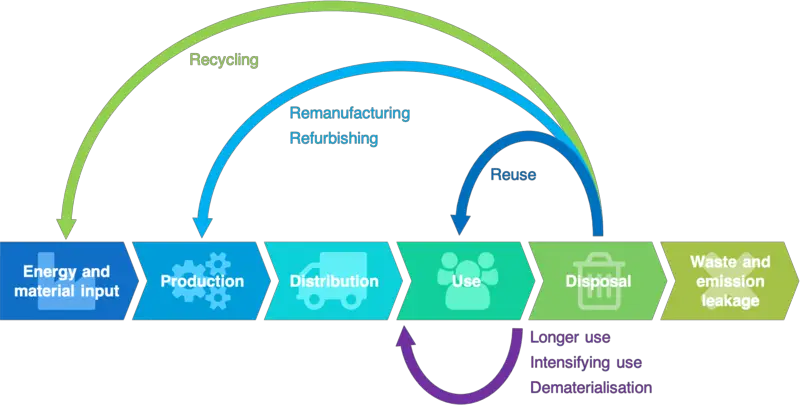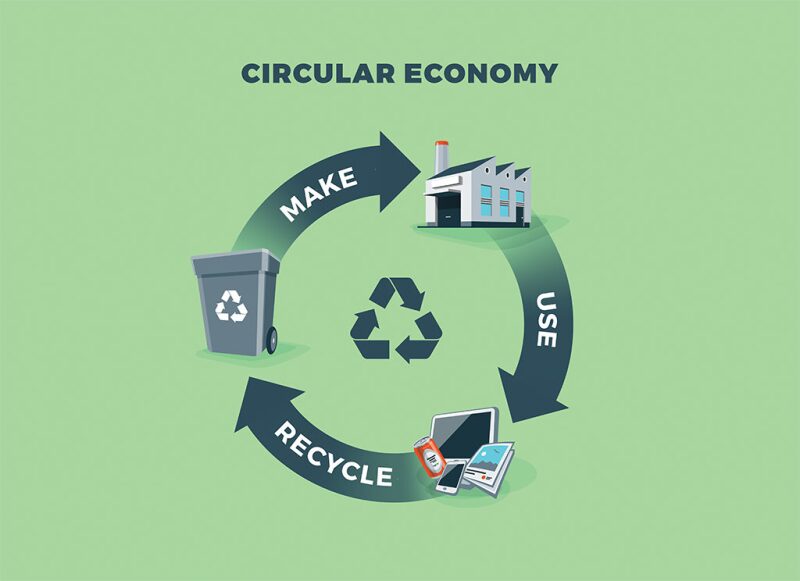Picture how our modern economy consumes enormous amounts of resources and generates mountain loads of waste each year.
How do we defuse this ticking time bomb that one day threatens to lay waste to our planet?
Well, many economists think they have figured a way out—it’s called a circular economy.
As its name implies, the circular economy or CE is an economic system that is circular. It can be contrasted with the old-style traditional economy which takes a linear shape.
CE has been hailed as the way to transform our economies so that they can be sustainable.
What is a Circular Economy?
simply put, a circular economy is a sustainable model that aims to eliminate waste and continually use resources by designing products for durability, recycling materials, and regenerating natural systems, fostering a closed-loop system of production and consumption.
Think of the economy as a conveyor belt. At one end, products are made or manufactured by producers.
On the other end, they are delivered to the consumer who uses them and then disposes of them, usually polluting the environment.
This is how a linear economy works.
A circular economy is different from this as the conveyor belt has its ends bridged together to form a closed loop. The products are manufactured, used, and recycled.
The idea is that materials (product or raw material) flow around the loop without exiting out.
To keep the materials flowing in the loop, they must retain value or functionality.
For example, the product has value for the customer while the waste produced by the customer has value for the producer as a raw material.
So, it never leaves the loop.
Circular Economy Vs Linear Economy
The linear system has a take, use, and dispose of design that strips away resources, putting our planet and future survival in jeopardy.
In a linear economy, products are designed to be used once and then disposed of.
But in a circular economy, products are purposely redesigned so that they can be used or reused for as long as possible.
The linear model deliberately designs products to have a short life also known as planned obsolescence which leads to overconsumption of resources.
The circular system emphasizes reuse and repair, which contributes to the replenishment and renewal of resources.
Other circular options apart from recycling include renting, repairing, sharing, renewing, upgrading, refurbishing, etc.
For example, if a product gets damaged, it is repaired instead of being discarded.
If it’s impossible to repair, it is used as raw material to make new products. This minimizes pollution, saves raw materials, curbs carbon dioxide emissions, and protects the environment.
So, waste becomes the raw material instead of being thrown away.
Circular Economy Examples

Here are 10 examples of circular economy in real life:
1. Plastic Waste
Plastics have brought great benefits to mankind but also untold damage to our environment.
Luckily, circular solutions give us new eyes to look at plastics as a renewable resource instead of waste.
For example, plastic packaging used for products can be recycled, and its reuse is encouraged in industries.
In one innovative way, chemical recycling can convert waste plastic such as plastic bottles, plastic discarded in oceans, and polyester textiles into food-grade PET (plastic packaging).
By creating a market for recycled plastics, fewer plastics materials will find their way into landfills and the natural environment.
2. Electronic Products Recycling
Next to the plastic waste problem, nothing comes closer than the problems posed by electronic waste or e-waste.
It is the fastest growing waste stream due to a growing consumer electronics market.
A circular economy addresses this issue by requiring electronic products to have more recyclable and recycled content.
They can also be designed for longevity so that they can be used longer. This can be done by enabling them to be easily repaired, refurbished, remanufactured, or resold.
3. Sharing Unused Products
Some products stay unused for lots of time or are standing still. For example, cars most of the time lie idle and unused by the owners when parked.
Instead of everybody having his car, sharing of unused cars can be encouraged to reduce the pressure on resources.
This can also be done with vacant building spaces or offices which can be rented out when not used.
This approach leads to less ownership of products but the intensive use of whatever products are there.
With fewer cars being used, there is less traffic and air pollution.
4. Circular Housing
New designs of houses can be adopted to make them multipurpose and flexible. This leads to fewer houses being built but serving multiple purposes.
For example, a hybrid building can be used as an evening school, a community center, or a flex work office.
The houses can also be constructed with the ability to be adapted to new evolving needs with time.
Also, they can be built with low-carbon construction materials such as hemp, straw, or wood to protect ecosystems and biodiversity.
5. Agriculture and Food
Producing enough to feed the world is no mean task.
It’s very expensive given the resources used and also the waste generated such as emissions and also the fact that about 30% of the food produced gets wasted or is thrown away.
As a result, some people have too much food (get overweight) and others are malnourished.
Circular solutions can fix this such as those offered by Agricycle which helps smallholder farmers to upcycle food and curb waste.
Using solar dehydrator technologies, food produced by the farmers can be preserved for longer.
The company then buys the food directly from cooperatives and sells them in the world market as brands. This ensures that farmers maximize their products and get good prices
6. Circular Cities
A circular economy can be applied to cities to create circular cities.
The benefit of this is huge since cities are great magnets for talent and innovation.
Because of its relatively small spaces, high concentration of people, data, capital, and talent, it’s excellently suited for circular services like reuse, or sharing models. This can enhance productivity while reducing waste, congestion, and costs.
An example of cities taking circular economy initiatives is Berlin using stormwater. This is captured through green roofs and cleaned in a treatment pond using energy-efficient methods.
The water can also be reused for flushing toilets and irrigation.
7. Fast Fashion Clothes
Fashion trends are notorious for changing quickly, so imagine how briefly people wear their clothes only to lay them aside for the latest fashion arrivals.
Each year, customers tend to buy more than ever before while wearing the clothes for even less time.
This is an opportunity for a circular economy or the sharing economy for customers who are conscious of the environment.
For example, the online platform, Vinted, provides users with a platform to sell, buy or exchange second-hand clothes.
8. Adopting Toxin-Free Products
In order to economize on natural resources and minimize pollution, the circular economy emphasizes recycling but what exactly is being recycled?
The recycled materials often have toxic chemicals which indefinitely stay in the loop.
To address this, industry and customers should opt for less polluting products to minimize damage to the environment.
For example, instead of chemicals or plastics that cause pollution, they can choose chemical-free consumables, bio-based products, organic compost, or natural fertilizers.
9. Dematerialization
Dematerialization refers to designing and delivering the equivalent product or service but with less or no material in it. (The mass in it has been reduced or removed).
A good example is digital products such as online news or streaming music which are sold virtually or electronically.
These are a transition from newspapers or physical CDs which reduces the consumption of natural resources.
Dematerialization leads to less need for holding inventory which reduces costs and protects the environment.
10. Adopting Circular Bioeconomy
The circular economy and bioeconomy can be brought together in a complementary way to form the circular bioeconomy.
A circular bioeconomy is driven by nature and supports the biological cycle in a circular economy.
It uses biological renewable resources for production. These products are also converted into value-adding biodegradable materials.
For example, charcoal which is used for household cooking in rural Kenya leaves fine dust as waste in sacks.
When collected and combined with a starch binding agent, it is converted into briquette which can be used as a fuel, making it a biofuel substitute to charcoal or coal.
This is a nonpolluting fuel leading to low carbon emissions.

Circular Principles/Concepts

The circular economy runs on 3 principles that are purposely built into it by design.
A. Eliminating Waste and Pollution
Our current economies which are largely linear, are modeled on a take-make-waste system.
In other words, raw materials are extracted from the earth, and products are created from them.
After customers have consumed them, the used product or its remains are thrown away as waste.
This waste is eventually lost as it is either dumped in landfills or burnt in incinerators. This is unsustainable in the long run as the earth’s finite resources are depleting.
B. Circulating materials and products which stay at their maximum value
Materials are always being used whether as a product or as raw materials. This ensures nothing goes to waste.
C. Regenerating Nature
The emphasis turns to regeneration and away from extraction, which is the hallmark of the linear economy.
A circular economy supports nature and allows it to thrive.
For this to work, product design is key. For example, we can have design strategies like ‘design-for-repair” or “design-for-recycling.”
The Cycles in the Circular Economy
The circular economy distinguishes between two production cycles, one that is man-made and the other biological, both designed to be closed loops in order to support the aims of the circular economy. They are:
- The Biological Cycle: Biodegradable raw materials extracted from nature flow in a closed loop. So what we loan from nature returns to nature.
- In the Technical Cycle: Man-made resources and materials e.g. electronics, plastics, or metals flow in a closed loop. This ensures that hazardous waste such as electronics do not leak or find their way into the environment.
Pros and Cons of Circular Economy
Pros:
- Consumers enjoy advantages like products that are durable and save them money.
- Stimulates innovation with the need to redesign new products
- Boosts economic growth by making the economy sustainable
- Secures supply of raw materials by minimizing their use and waste
- Creates jobs: For example, it’s projected to generate 700,000 jobs by the EU just in the EU bloc alone.
- Increases competitiveness.
Cons:
- Low Demand: Given that the world economy is still only 9% circular, there is a low engagement or incentive for producers to invest in them.
- High Start-Up Costs: The initial setup of circular-oriented businesses will entail high costs because new technologies and materials will need to be acquired.
- Cooperation of business-to-business (B2B) cooperation is challenging: Circular economy cannot work with businesses adopting it singly. It requires wholesale adoption by industry to work optimally but mindsets are yet to shift.
- Lack Of Information: The industry is new and relatively few people have sufficient information regarding product design and production
- Complex Supply Chains: New sets of suppliers will be needed such as manufacturers of parts
- Lack Of Technical Skills: Circular strategies is a new area so technical knowledge and expertise are still low or poor
- Compromised Quality: the transition period is likely to experience lower quality in products since many processes are still yet to be perfected
- Time-Consuming and Expensive: Some aspects of CE will entail additional time and cost such as the disassembly of products.
Potential Barriers to Circular Economy
Switching to a circular economy model faces several hurdles such as:
- Too much of our economy is still based on linear economy giving little scope for circular economy producers to operate
- Current laws and regulations are still geared to the linear economy
- Many businesses still operate with a short-term focus on value creation. But the circular economy is the opposite of this since it is long-term value creation
- Significant cultural change is needed to make a change
Implementation of the Circular Economy
Successful implementation of a circular economy requires a change in the behavior of both producers and consumers.
For example, consumers should want to use their products longer. Or they should be willing to repair them or deliver them to recyclers.
Governments can intervene through policies and enabling infrastructure to give incentives for the desired behavioral changes.
For example, they can provide convenient collection points for customers to leave their used products.
International institutions like the UN or World Economic Forum can also spur interest and adoption of CE by placing it high on the world agenda.
Is The Circular Economy Sustainable?
There is a looming crisis of a rapidly growing world population with ever higher demand for raw materials and a limited supply being depleted.
Since the linear economy fails to address it, disaster looks inevitable.
The circular economy squarely addresses the issue of resource depletion and waste, so experts believe that it is sustainable.
Conclusion
By shifting from a linear to a circular economy, can humans now heave a collective sigh of relief?
After all, who needs to endlessly contemplate the gloomy prospects promised by the linear economy?
After 150 years of industrial mayhem, we can now envision a waste-free planet and a world that protects our collective dignity and happiness.

